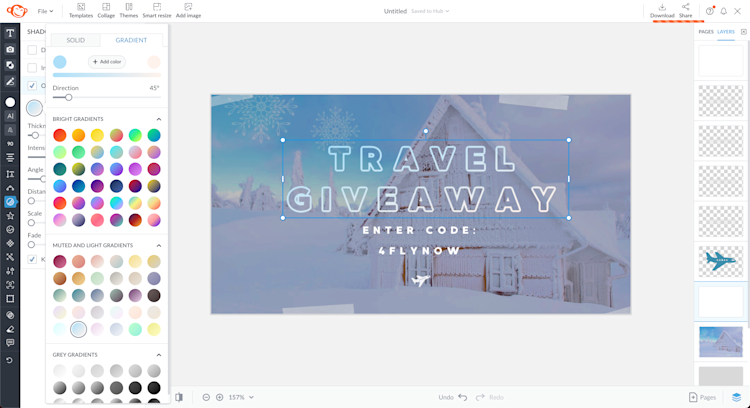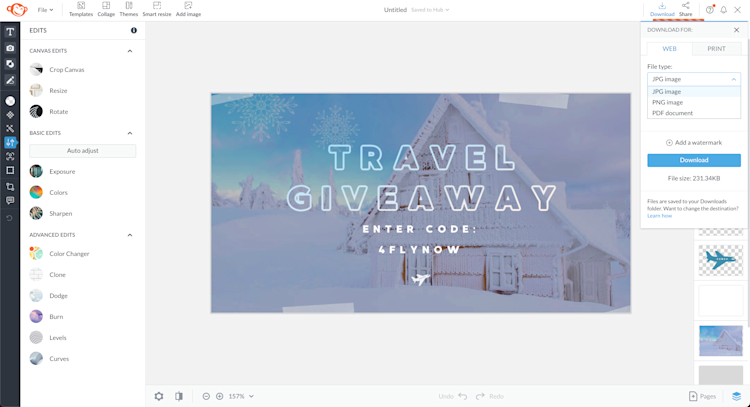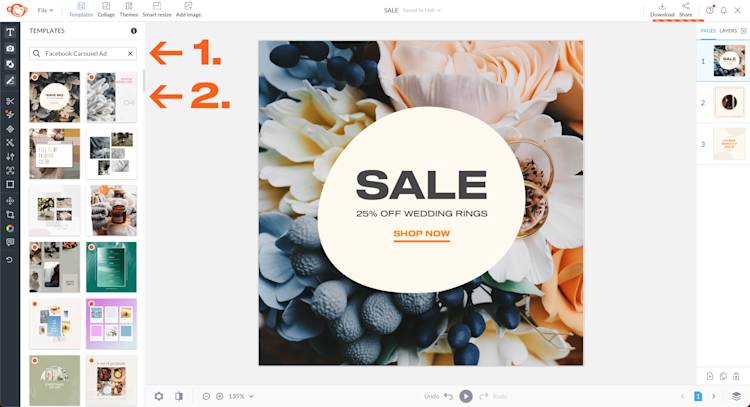In a social media world with influencers abound, it can be overwhelming to compete with the pros. If you’re stepping into the Facebook ad frenzy for the first time, we promise you’re in good hands. Knowing how to make a Facebook ad won’t only boost your marketing skills, but it’ll change your life. You might be thinking, Psh, as if. But really — consider what 1.84 billion daily Facebook users interacting with your Facebook ad could do for business. Success is in the air. Can you feel it?
Our PicMonkey tutorial is for all types of Facebookers. Here, we’ll cover:
Types of Facebook ads
Facebook has ad formats for any business. Among ever-advancing modern-day technology, you now have options ranging from single image ads, carousels, slideshows, collections, playable ads, and more. While decision-making paralysis is real, PicMonkey condenses and optimizes whatever you need with countless templates and design tools.
Facebook ad sizing 101
| Facebook ad type | Size (in pixels) |
|---|---|
| Image ad | 1200 x 628 (max 30 MB file size) |
| Video ad | 1080 x 1080 (max 4 GB file size) |
| Stories ad | 1080 x 1920 |
| Messenger ad | 1200 x 628 |
| Carousel ad | 1080 x 1080 |
| Slideshow ad | 1080 x 1080 |
| Collection ad | 1200 x 628 |
Regardless of the ad you start with, recognizing their sizes builds long-term confidence. Now, let’s walk you through some of the most popular Facebook ads.
How to build a single image Facebook ad
While single image Facebook ads are simple, every design element matters. In addition to an image, these ads have one headline, a link description, and a CTA button.
As our sizing chart shows above, single image Facebook ads should be high resolution, 1200 x 628 pixels. The image ratio is 9:16 or 16:9 with file type options for PNG or JPG.
To build a single image Facebook ad in PicMonkey, just click Create new > Templates from the homepage. Type “Facebook Ad” into the search bar, and choose your favorite.
Make a stand-out ad with your own archived photos, or choose from PicMonkey’s stock photo library.

Once you've swapped your pic(s), use the left menu options to change your font, colors, and add design elements like graphics & effects.
In our example, we added an outline to our text, using the Text Tools menu. Then we changed the outline's color (hey, color gradients).
Pro Tip: For the most effective single image ad, don’t use more than 20% text! There’s no rule against it anymore, but the text-to-ad ratio is crucial for user-friendliness and post engagement.

Once you’ve finished your Facebook ad, click Download on the top toolbar and download as a JPG or PNG.
Alternatively, you can click Share and export your design straight to Facebook! You’ll be prompted to connect your account and choose the Ad Account ID for your image. Once you’re connected, you can fill out the headline, link description, and remaining text.
No matter what, it'll save in Hub, PicMonkey's cloud storage, if you ever need to come back and edit.
How to make a Facebook carousel ad
Bump up your Facebook ad game with the carousel ad option. Carousel ads — 1080 x 1080 specs — let you sport 2-10 images and/or videos at once with customized headlines and links. Readers engage by clicking an arrow to scroll through the images.
When should you use a carousel ad?
Carousel ads are best for storytellers, step-by-step guides, and featuring multiple products. Reader engagement skyrockets when you pair strong images with important information. Given that you’ll only have 125 characters on Facebook to strut your stuff, be discerning about what text to include in and on your images. Balance is key — too much or too little text can skew your engagement!
Cohesion and consistency are your best friends here. Having similar fonts, styles, themes, and backgrounds throughout each image keeps your story fluid. One way to do this is by cropping a single image multiple times in order to get a seamless look.
And if you’re like, PicMonkey, really? I don’t have a story, I’m just selling wallets...we hear you. The truth is, everything you post should have some representation of your brand; this turns one-time clients into returning ones. Gone are the days where products speak for themselves. Hello, social media marketing.

Just like with single image ad templates, you can browse carousel ad designs in PicMonkey and get right to customizing.
Once you find the right money-making template, feel free to sub out the text, background images, colors, and more.
Plus! Check out PicMonkey’s multi-page tool to duplicate designs and re-edit them. This way, you can develop consistency amongst your 2-10 scrollable pics without starting from scratch each time or having to fight with fonts.
Pro Tip: Lifetime customers are ones with whom you’ve instilled emotional value. Be discerning. The right visual tools build that magnetism.
How to make a Facebook ad slideshow

Looking for an immersive experience? Cue Facebook slideshow ads! While carousel ads use multiple images and/or videos to scroll through, slideshow ads have animated, timed, and flashing images.
It’s time to level the tech playing field. Slideshow ads are proof that high-end designs are not only for those with experience. Don’t worry — you’re not responsible for making them move. You just want to make sure your images have text in the same exact spot for when they slide, to enhance the illusion.
Pro Tip: Facebook will crop your slideshow into the appropriate size, but you can resize your pics in PicMonkey to avoid cropping, too. Even better, use our Smart Resize tool to reformat your design for multiple uses, like Facebook ads, stories, or Instagram–stress-free!
Benefits of Facebook slideshow ads
Let’s jazz up this party with some motion. Slideshow ads are right for you if you:
Want to use video without production costs or experience
Prefer visual stories
Need to diversify your visual marketing
Pro Tip: Remember, using similar photo effects, fonts, and positioning will make for a smooth transition into the slideshow.
Make a Facebook ad from scratch with a blank canvas
As is true in any classroom, some students prefer to color outside the lines. If that’s you, starting from scratch is a wise option. So, while PicMonkey’s templates are unmatched, let’s explore the blank canvas infinity.

On the PicMonkey homepage, click Create New > Blank Canvas and select "Facebook Ad." Remember, your canvas will already be sized appropriately — 1200 x 628 pixels.
Just like with a template, you have options aplenty waiting for you on the left menu. Here, you can play with various background colors, fonts, and graphics to bring your vision to life!

In our example, we've used the Draw tool to create a realistic watercolor texture in support of the advertisement.

Like any other Facebook ad design, you can choose to download and upload to Facebook yourself, or share directly to Facebook from PicMonkey.
As you upload, the format will vary slightly depending on which ad type you chose to make, but Facebook will walk you through it (thanks Facebook).
Facebook ad tips
Strong designs won’t replace your sales scripts (and vice versa), so follow these tips to ensure a marketing home run.
Know Facebook’s guidelines to optimize character counts and quality content
Obey Copyright regulations including photo credits and brand logos
Sport your own brand and logos throughout your post to build brand awareness
Make your Facebook ad public for high consumer engagement
Pro Tip: After your first ad launch, you might experience a surge in energy. Call it adrenaline, accomplishment, or the prospect of fame. Side effects might include the insatiable desire to make more Facebook designs. We’ve got you covered with this Facebook banner tutorial. Or, learn how to polish your presence with these top-notch Facebook post ideas.
Track your ad and celebrate
Woo! So your Facebook ad is live. Now what? Do you sit back and wait for the millions to roll in? Likely not. While you should definitely take some moments to breathe and celebrate, it’s crucial to track your ad engagement and conversion rate. Why?
These numbers are the best feedback for your business growth. The prettiest ads mean nothing if they’re not reaching the people (and this is all about the people). Learn what’s resonating for folks and what you can improve next time. Don’t worry, Facebook Ads Manager offers data and reports to help you understand your ad performance.
This tutorial is designed to empower, not hinder, your infinite creative potential. Options aren’t meant to overwhelm, but to liberate. Bask in the glory of PicMonkey abundance and go forth with creative confidence. Now that you’ve learned how to make a Facebook ad, we know there’s nothing you can’t do.
